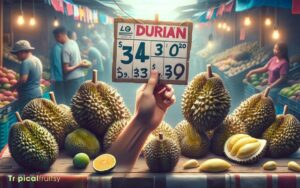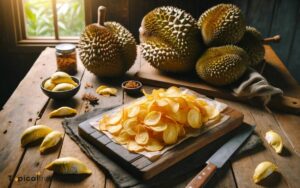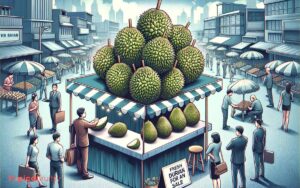Which Country Has the Best Durian? Revealed!
Determining which country has the best durian varies by individual taste, but Malaysia, Thailand, Indonesia, and the Philippines are often lauded for their exceptional varieties.
Malaysia’s Musang King is highly sought after for its rich, creamy texture and strong flavor.
Thailand’s Monthong is favored for its sweet and custardy taste.
Indonesia boasts a wide variety of durian types, each with distinct flavors, and the Philippines is celebrated for the almond-like taste of its Duyaya durian.
The search for the finest durian involves considering the unique durian varieties cultivated in different Southeast Asian countries.
Here are some key points about the top contenders:
The ‘best’ durian is subjective and can depend on factors such as personal flavor preference, texture, and aroma tolerance.
Experience the decadence of Southeast Asia’s king of fruits; each country offers a unique durian delight that caters to varied palates.
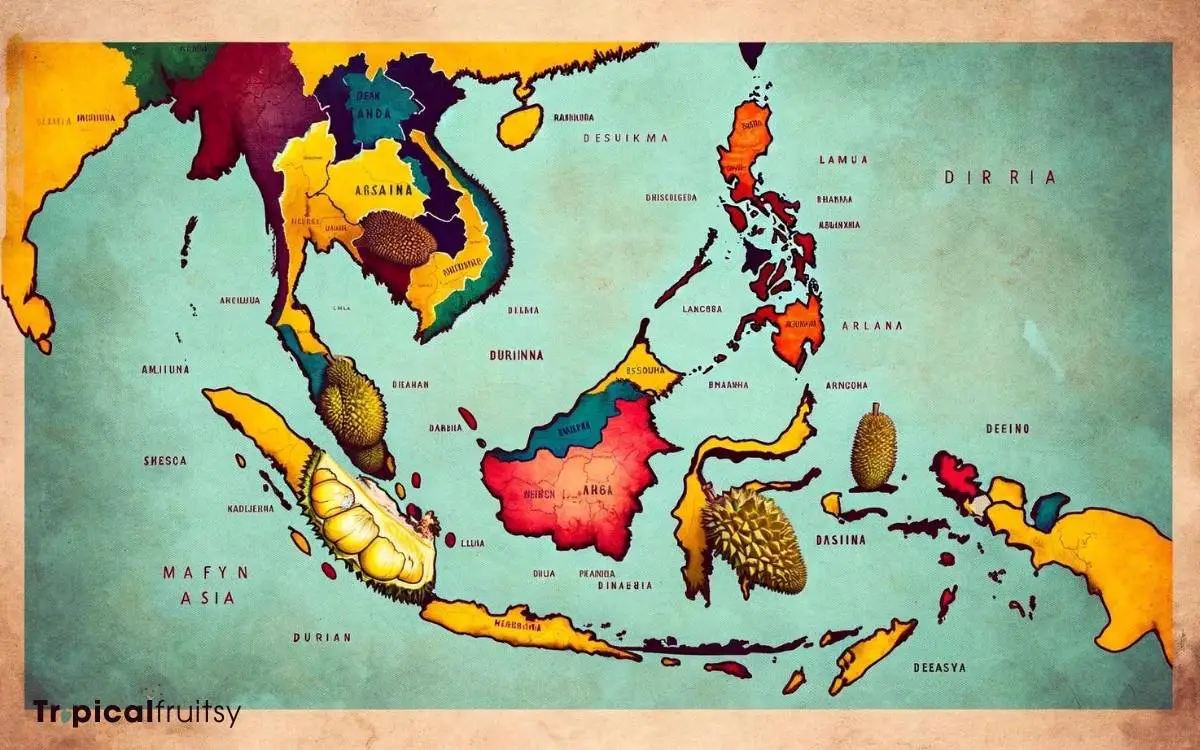
Key Takeaway
Discover the Best Durian Varieties by Country
| Country | Variety | Description | Notable Qualities |
|---|---|---|---|
| Malaysia | Musang King | Creamy texture, deep golden flesh, robust taste | High demand, premium variety |
| Thailand | Monthong | Sweet, custardy taste, less pungent aroma | Widely available, often less fibrous |
| Indonesia | Various | Ranges from sweet and creamy to bitter | Diverse selection, unique to each region |
| Philippines | Duyaya | Almond-like flavor, less common | Nutty taste, smooth texture |
The Durian Phenomenon
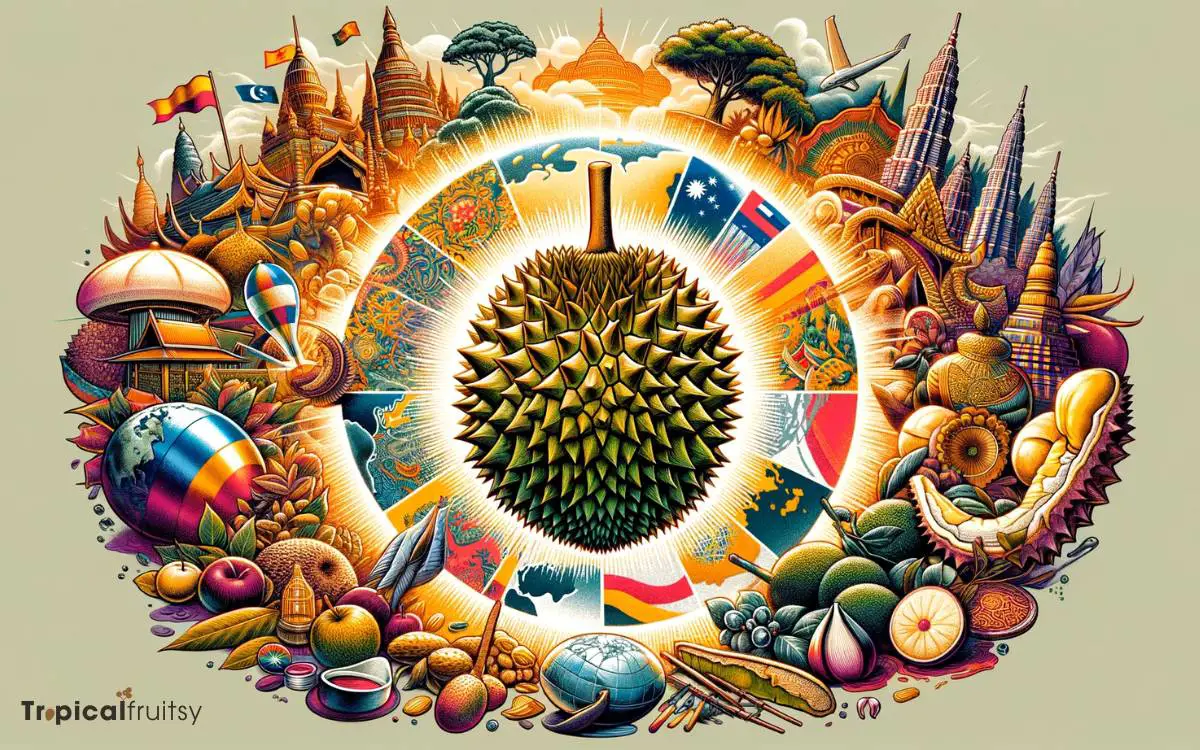
The durian phenomenon, a cultural obsession and gastronomic adventure, has propelled this pungent fruit to international fame, sparking debates over which country produces the superior variety.
Native to Southeast Asia, the durian’s notoriety stems from its potent aroma, often compared to a melange of savory, sweet, and sulfurous elements.
Connoisseurs prize the durian for its custard-like texture and complex flavor profile, which varies dramatically between species and regions.
As durian cultivation matures, distinct cultivars have emerged, each with unique characteristics that fuel regional pride and intense competition.
Analyzing factors such as soil composition, climate, and agricultural practices offers insight into the intricate variables that contribute to the fruit’s quality.
This pursuit of excellence leads us to Malaysia’s Musang King, a cultivar that stands as a pinnacle of durian sophistication.
Malaysia’s Musang King
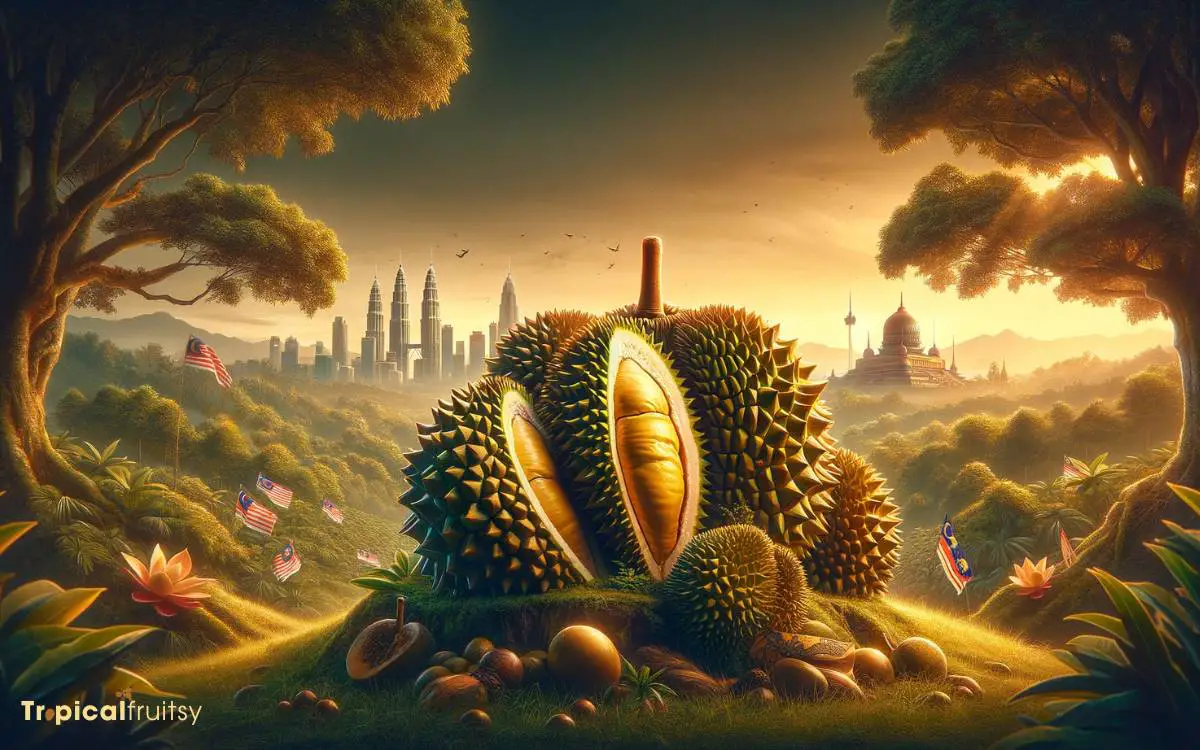
Malaysia stakes its claim as the premier durian producer with the Musang King variety, renowned for its exceptional taste and texture.
This cultivar, also known as D197, is celebrated for its deep, vibrant yellow flesh and seductively creamy consistency that delivers a complex balance of sweet and bitter flavors.
Musang King has a thick, buttery texture that lingers on the palate, a hallmark of its superior quality.
| Feature | Description | Significance |
|---|---|---|
| Color | Vibrant yellow | Indicates ripeness |
| Texture | Creamy and thick | Enhances eating experience |
| Taste | Balance of sweet and bitter | Appeals to connoisseurs |
| Cultural Value | Highly prized in Malaysia | Reflects national pride |
Thailand’s Monthong Variety
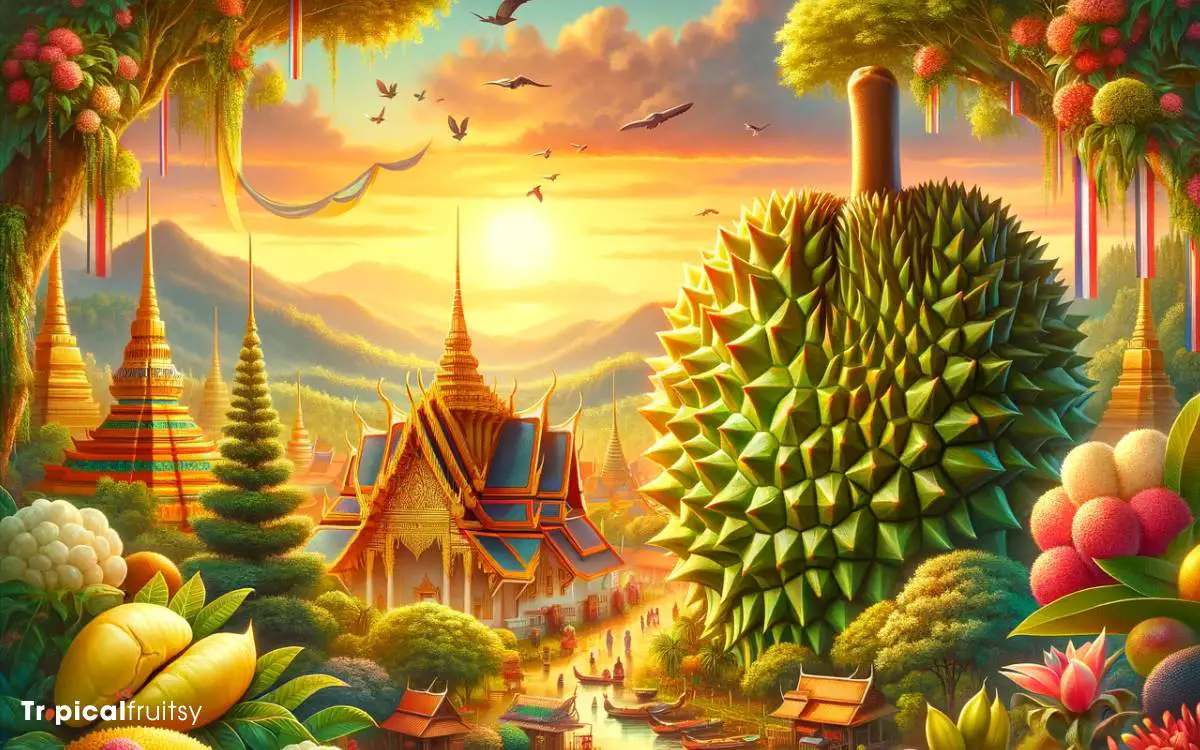
Thailand’s Monthong durian, known for its sizeable golden pods and moderately sweet flavor, stands as a formidable contender in the global durian market.
The Monthong, or ‘Golden Pillow’, is prized for its creamy texture and subtle bitterness that underlies the sweetness, offering a complex taste profile that appeals to both connoisseurs and new consumers alike.
Its flesh, characterized by a firm yet custard-like consistency, makes it particularly versatile for both fresh consumption and culinary applications.
Cultivated extensively across Thailand, the Monthong variety has achieved significant commercial success, with its export quality fruit consistently meeting stringent international standards.
This has not only bolstered Thailand’s reputation as a leading durian exporter but also established Monthong as a benchmark for premium durian varieties.
Indonesia’s Durian Diversity
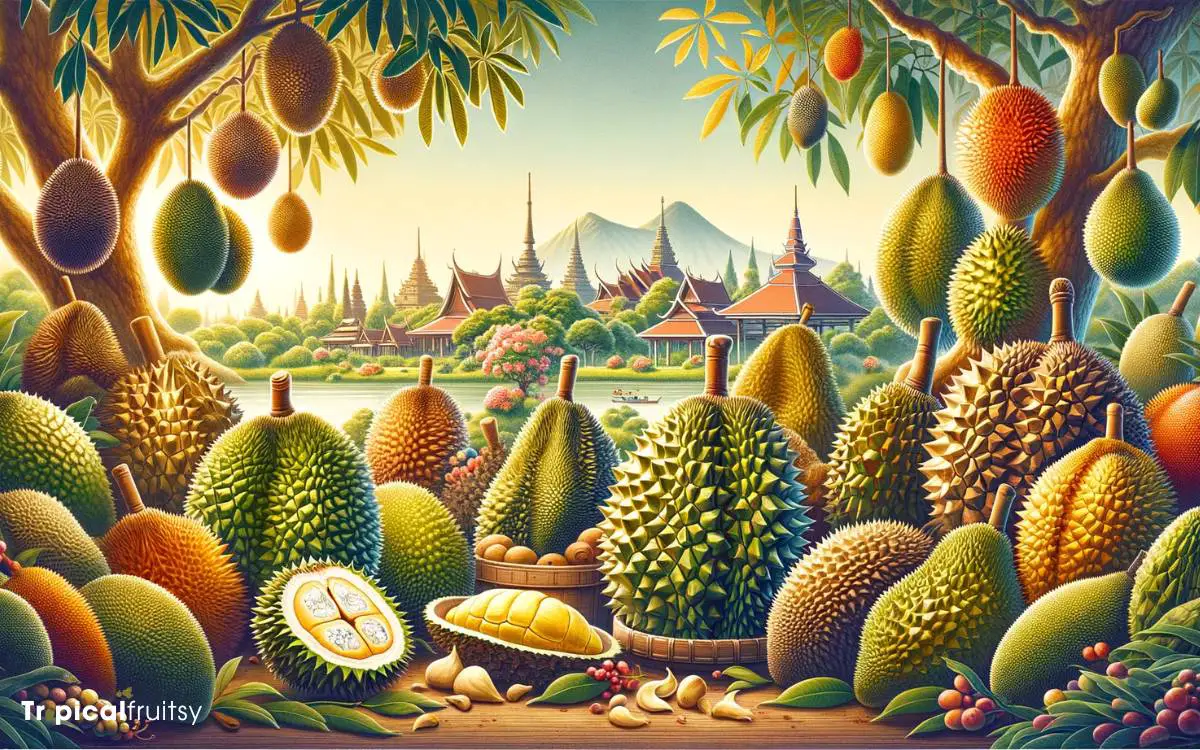
Turning our attention to Indonesia, the country presents a remarkable array of durian varieties, each boasting a unique spectrum of flavors and textures.
The diverse climatic conditions across the Indonesian archipelago contribute to the cultivation of durian types that range from the sweet and creamy to the more complex, with hints of bitterness or even alcoholic notes.
This diversity not only reflects the rich agricultural heritage of Indonesia but also poses a significant challenge in determining the finest durian, as flavor profile preferences are highly subjective among enthusiasts.
Varied Durian Varieties
While Indonesia may not be the first country that comes to mind when discussing durian, its vast archipelago is home to a remarkable diversity of durian varieties, each with unique characteristics and flavors.
The country’s rich volcanic soil and tropical climate create an ideal environment for cultivating a wide array of durian types, which are often less known internationally but cherished locally.
- Musang King: Revered for its creamy texture and robust taste that evokes a blend of sweet and savory.
- Petruk: A local favorite that offers a bittersweet experience, reminiscent of caramel and bitter almonds.
- Sukun: Thick flesh with a mild sweetness, invoking a sense of comfort akin to custard.
- Graveolens: Known for its distinctive orange flesh and pungent aroma that stirs a passionate debate among durian aficionados.
- Bawor: A premium variety with a complex flavor profile that dazzles the palette, much like a fine wine.
This richness in variety underscores Indonesia’s underrated position in the global durian landscape, providing a spectrum of sensory experiences for the fruit’s enthusiasts.
Flavor Profile Differences
Indonesia’s durian diversity presents a wide array of flavor profiles, ranging from intensely sweet to complexly savory, catering to a variety of palates.
Each region contributes distinctive tastes, influenced by differences in soil, climate, and cultivation practices.
For instance, durians from Sumatra may exhibit a strong, pungent aroma with a rich caramel undertone, while those from Java can offer a lighter, more nuanced sweetness accompanied by a slightly bitter aftertaste.
Connoisseurs appreciate the multifaceted sensory experiences provided by Indonesian durians, noting the subtle hints of almond or chocolate in some varieties and the lingering taste of roasted onion in others.
This diversity underscores Indonesia’s unique position within the durian landscape, offering a gourmet journey for enthusiasts seeking depth in their durian tasting experiences.
The Philippines’ Duyaya
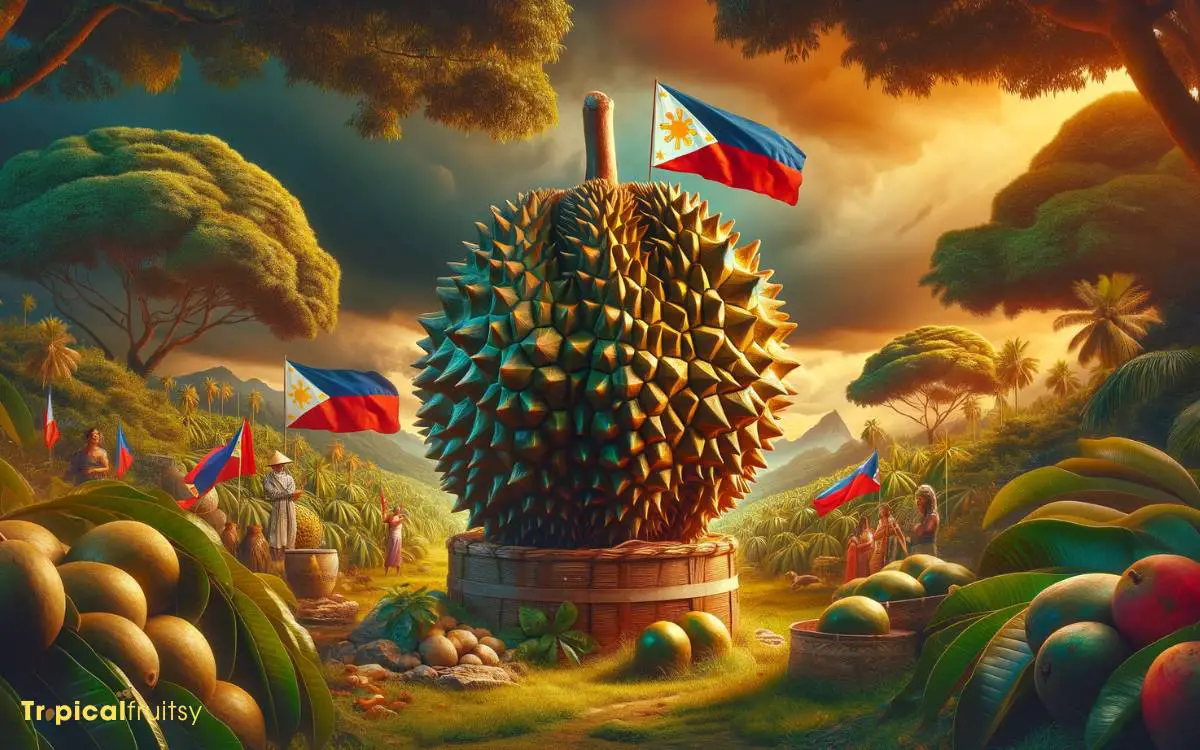
Several varieties of durian can be found in the Philippines, among which the Duyaya stands out for its distinct flavor profile and creamy texture.
This particular variety has garnered attention not only for its taste but also for its rarity and cultural significance. Analyzing the Duyaya’s characteristics reveals why it is highly regarded among durian enthusiasts.
- Aromatic Allure: The Duyaya’s scent hints at a complex bouquet, weaving sweet and earthy notes that captivate the olfactory senses.
- Visual Delight: Its vibrant yellow flesh promises a feast for the eyes, suggesting a richness that tempts the palate.
- Silken Seduction: The texture is voluptuously creamy, melting effortlessly in one’s mouth.
- Taste of Tradition: Each bite carries the legacy of Filipino durian cultivation, a testament to the land’s fertility and growers’ dedication.
- Emotional Euphoria: Consuming Duyaya often evokes a profound sense of satisfaction, connecting one to the essence of tropical indulgence.
Vietnam’s Durian Scene
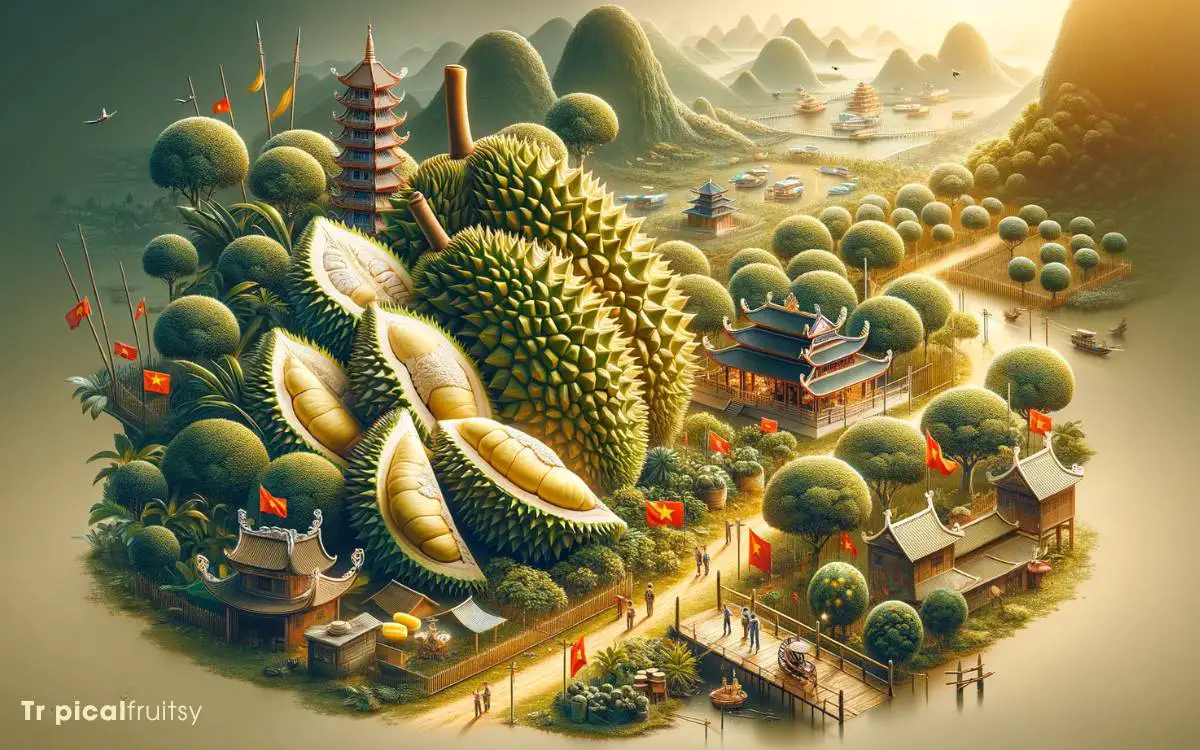
Vietnam’s contribution to the durian landscape is defined by its array of popular varieties, each with unique taste profiles that cater to both local and international palates.
The country’s durian festivals serve as a testament to the fruit’s cultural significance, offering a platform for growers to showcase their finest cultivars.
These events not only celebrate the king of fruits but also provide a lens through which the vibrancy and diversity of Vietnam’s durian scene can be observed and appreciated.
Popular Varieties
Within the lush landscapes of Vietnam, the ‘Sầu Riêng Ri 6’ emerges as a highly sought-after durian variety, prized for its creamy texture and sweet taste.
The fervor for this particular type of durian is reflective of Vietnam’s rich agricultural diversity and the country’s dedication to cultivating exquisite fruit varieties.
- Sensory Delight: The ‘Sầu Riêng Ri 6’ tantalizes with a symphony of rich, custard-like flavors.
- Visual Appeal: Its vibrant, golden flesh promises an indulgence for the eyes and palate.
- Aromatic Allure: A potent, yet pleasantly sweet aroma captivates the senses, inviting a moment of tropical escapism.
- Cultural Connection: Each bite offers a taste of Vietnam’s lush, verdant orchards and the meticulous care of local farmers.
- Exclusive Experience: Savoring this variety becomes a cherished memory for connoisseurs and casual enthusiasts alike.
Analyzing the popularity and quality of this variety sets the stage for an exploration of cultural celebrations surrounding durians.
Durian Festivals
Numerous durian festivals across Vietnam celebrate the country’s passion for this unique fruit, showcasing a vibrant aspect of its agricultural heritage and community spirit.
These events serve not only as a testament to the fruit’s popularity but also as a platform for farmers to present their finest durians, often resulting in competitive yet festive atmospheres.
Expertly judged contests, tasting sessions, and educational workshops offer insights into the complexities of durian cultivation and appreciation.
Participants revel in the myriad of flavors and textures offered by different durian varieties, each region boasting its own prized cultivars.
As Vietnam’s durian festivals highlight the cultural significance and economic impact of this thorny delicacy, the narrative shifts to Cambodia’s unique offerings, where the durian’s role in local traditions and gastronomy paints another layer of the Southeast Asian durian tapestry.
Cambodia’s Unique Offerings
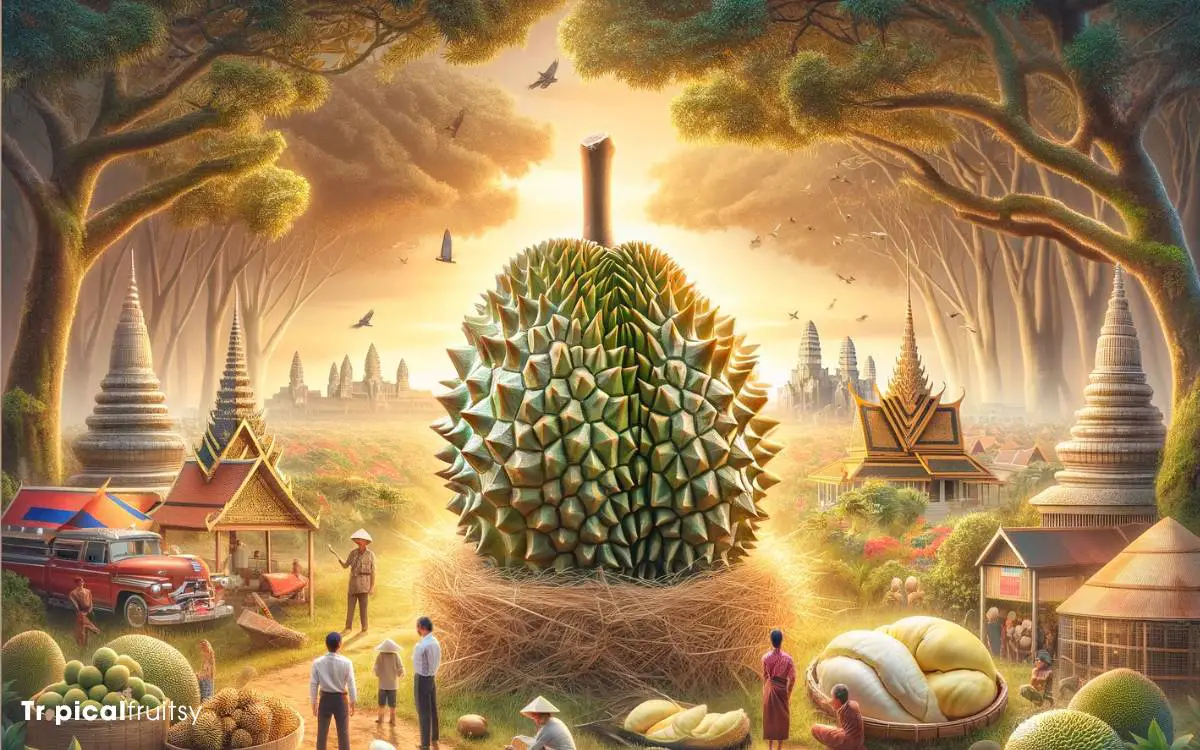
Cambodia’s durian orchards, particularly in the Kampot and Kampong Cham regions, are renowned for producing the ‘Kampot Durian’, a variety with a distinctively potent aroma and rich flavor that commands a premium status in the market.
The country’s unique offerings provide a compelling narrative for durian connoisseurs searching for an exceptional experience.
- The Kampot Durian is recognized by its golden hue, embodying the warmth of Cambodia’s tropical sun.
- Its creamy texture whispers tales of lush Cambodian soil nurturing every fruit to perfection.
- The complex flavor profile is a symphony of sweet and savory notes, leaving a lingering melody on the palate.
- Each bite offers a transcendent journey through Cambodia’s rural heartlands.
- The fruit’s rarity and distinctive taste symbolize the rich cultural tapestry of the nation.
As we savor the luxurious essence of Cambodia’s durian, our journey through the treasures of Southeast Asia leads us to Brunei’s hidden gems.
Brunei’s Hidden Gems
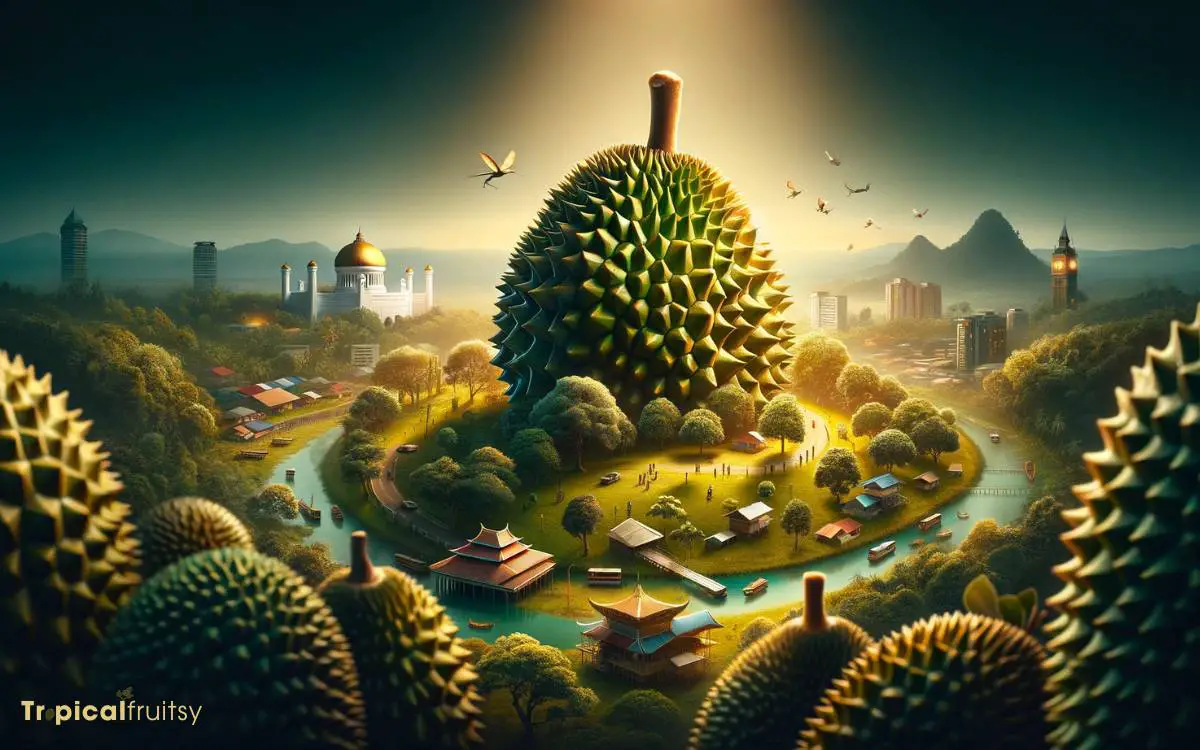
The Sultanate of Brunei, though less prominent in the durian world, offers a selection of local varieties that are both rare and exquisite.
Nestled in the biodiverse rainforests of Borneo, Brunei’s durian fruits encapsulate unique flavor profiles that are the culmination of the nation’s pristine natural environment.
Connoisseurs might find the Bruneian durian to possess a complexity that is reflective of its terroir—a term borrowed from the wine industry, but equally applicable here.
Analyzing these hidden gems, one can discern a creamy richness and subtle sweetness that are hallmarks of Brunei’s durians.
The texture tends to be velvety, while the aroma can range from mildly fragrant to intensely pungent, depending on the variety.
For the durian enthusiast, Brunei’s offerings are a testament to the region’s lesser-known, but no less significant, contribution to the durian pantheon.
Singapore’s Durian Love Affair
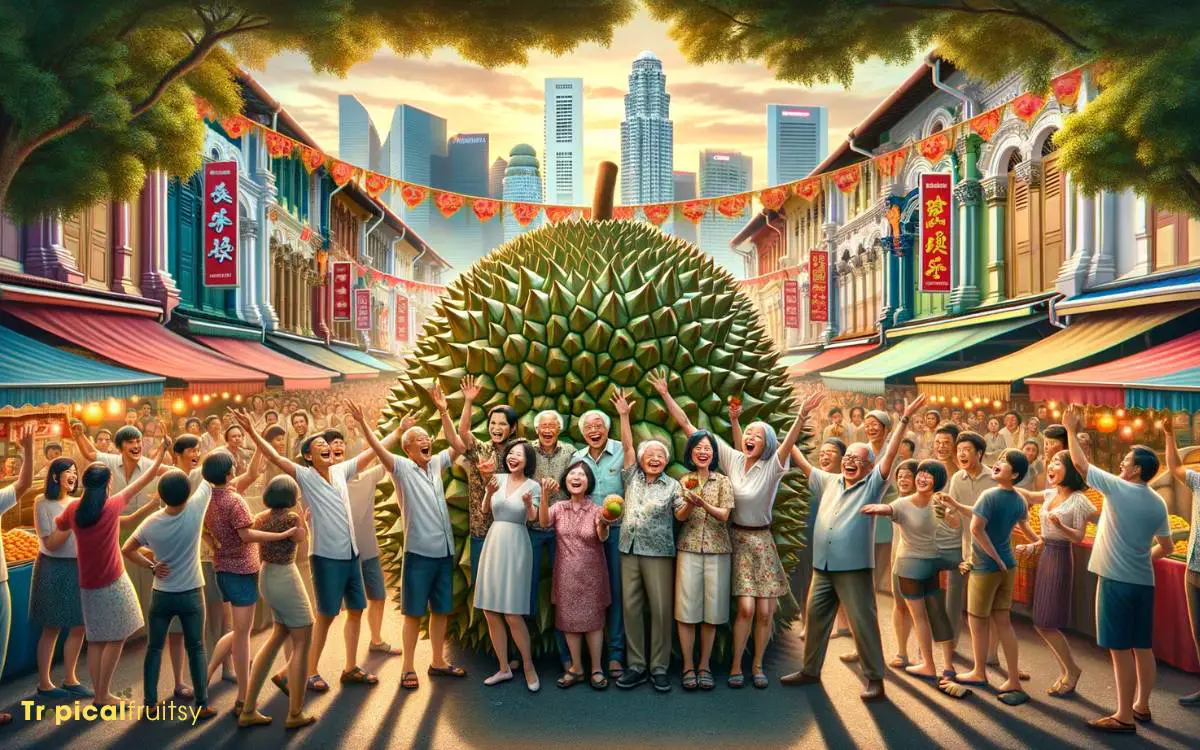
Singapore’s affection for durian is deeply ingrained in its cultural fabric, with the fruit often hailed as the ‘King of Fruits’ within the city-state.
The relationship between Singaporeans and this pungent, thorny fruit is nuanced, reflecting both a national obsession and a symbol of heritage.
The fervor for durian is not merely about taste—it is a phenomenon that encapsulates tradition, community, and identity.
- The enduring tradition of durian parties brings families and friends together, showcasing the fruit’s role in fostering social bonds.
- A sense of national pride emanates from the local durian varieties, with names that resonate with the country’s heritage.
- The anticipation of durian season creates a palpable excitement, akin to a festive celebration.
- The meticulous search for the perfect durian reflects the Singaporean dedication to culinary excellence.
- The durian’s divisive nature spurs passionate debates and discussions, highlighting its significance in the cultural discourse.
Analyzing Singapore’s durian culture reveals a complex tapestry of emotional connections, where every spiky shell and creamy bite is interwoven with the city’s collective heartstrings.
Which Country Produces the Most Durian
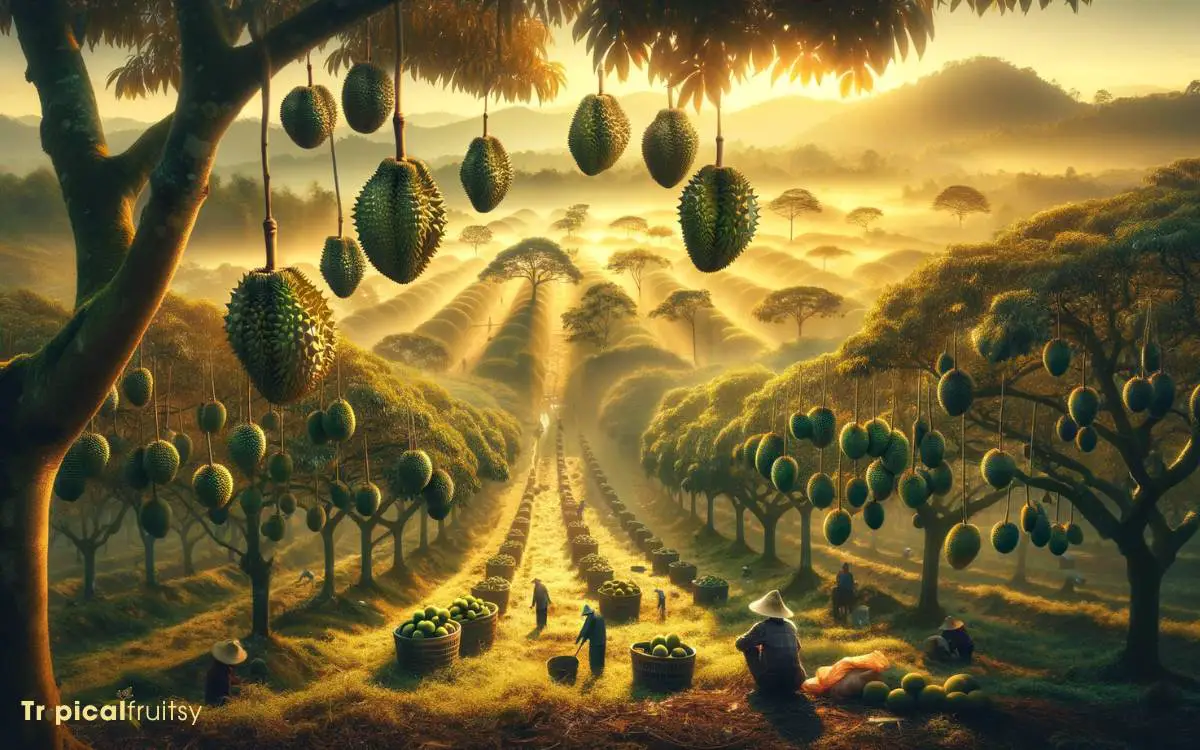
Thailand is the largest producer of durian in the world. It not only leads in production but also in exporting, catering to a significant portion of the international demand for durians.
Thailand’s durian farms produce a variety of durian species, including the popular Monthong (Golden Pillow), which is favored for its sweet taste and relatively mild odor compared to other varieties like the Musang King.
Malaysia and Indonesia also contribute significantly to the global durian production, with Malaysia being renowned for its premium varieties such as Musang King.
Indonesia, on the other hand, offers a wide range of local durian varieties that are less known internationally but are highly valued in domestic and neighboring markets for their unique flavors and qualities.
The climatic conditions, soil type, and farming practices in these Southeast Asian countries make them ideal for durian cultivation, allowing them to dominate the global market in durian production and export.
Conclusion
The quest for the finest durian is as much about personal preference as it is about regional pride.
The Musang King reigns supreme in Malaysia with its creamy texture and robust flavor, while Thailand’s Monthong is prized for its consistency and sweetness.
Indonesia, the Philippines, Vietnam, Cambodia, and Brunei each contribute their unique strains to this rich tapestry.
Like a mosaic of culinary jewels, each country’s durians offer a distinct taste that, together, define the spectrum of flavors in this king of fruits.


